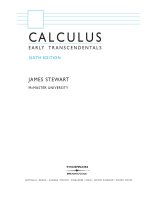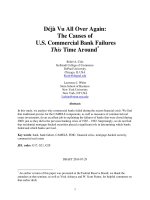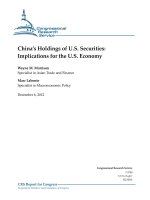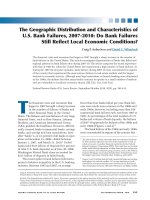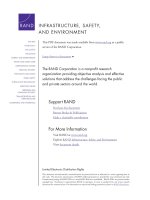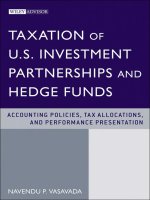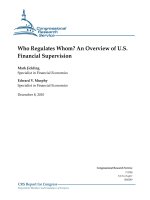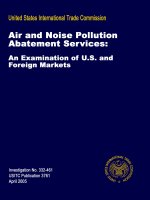Financing decisions of u s REITs a capital market perspective
Bạn đang xem bản rút gọn của tài liệu. Xem và tải ngay bản đầy đủ của tài liệu tại đây (1.28 MB, 140 trang )
FINANCING DECISIONS OF U.S. REITS
A CAPITAL MARKET PERSPECTIVE
LI LIN
(B.Sc. Eng Tsinghua University)
A THESIS SUMITTED FOR THE DEGREE OF MASTER OF
SCIENCE (ESTATE MAGAGEMENT)
DEPARTMENT OF REAL ESTATE
NATIONAL UNIVERSITY OF SINGAPORE
2004
ACKNOWLEDGEMENTS
路漫漫其修远兮,吾将上下而求索
---屈原
The two years of Master program at Department of Real Estate at NUS is indeed an
exciting and rewarding experience.
From an engineering student who understood little
about business and finance at the beginning of the program, to the completion of a
master level thesis on REITs financing, the learning curve is surely steep.
Among
others, I have to learn from scratch the principles of finance, the capital market as well as
the real estate industry. In addition, research methodology of social science is very
different from that of engineering, particularly the various econometric models and
financial databases.
The most challenging part however, is perhaps the change of
mind-set. Trained as an engineer, I used to have one definite answer to one question.
However, in business and finance, this is never the case, as evident in the development of
the capital structure theory, there are always different thoughts from different
perspectives, each of which has it merits and shortcomings.
At the end of the day, a
combination of all these schools of thought is needed to truly understand the observed
phenomenon in the real business world. Though this shift in the way of thinking is a
bit painful at the beginning, I finally learned to appreciate this most charming point of
the discipline.
Never writing an English article longer than one page before the Master program,
academic writing in a foreign language also poses a challenge for the study.
Quite often,
I spent five minutes putting a comma into a sentence, and another five minutes to take
the same comma out.
The writing of a thesis on the topic of financing decisions of U.S. REITs is spurred by
my interest in corporate finance as well as the rapid development of the REIT market in
the Asia Pacific, particularly here in Singapore. Although the emergence of Internet
makes the idea of writing a U.S. topic thesis while living in a city-state in Asia possible,
i
lacking “local knowledge” about U.S. REITs is still one of major short-coming of this
study.
Most of the understanding about U.S. REITs is gained through reading a lot of
academic papers, text books, analyst discussions, research reports and company financial
statements.
However, despite all these challenges and difficulties, I managed to get this work done
within the master program time-frame. The completion of the thesis would not have
been possible without the help of support of the faculty at the department, my family
and friends.
Our department provided me with a research scholarship as well as first-class courses
and facilities during the course of the program. It also sponsored us to gain exposure,
by attending international real estate conference.
The knowledge I learned during the
program is priceless and has the power to change my entire life.
In particular, I would
like to express my sincere gratitude to my supervisor, Dr. Joseph Ooi for his supervision
and guidance.
He taught me the way of conducting serious academic research, his
insights also inspire many ideas in this work. Despite being busy, he took time to read
every single sentence of the first draft of the thesis.
The knowledge learned from the course work of Associate Prof. Ong S.E. and Associate
Prof Sing T.F., as well as Associate Prof Liow K.H. lay the foundations of this study.
Prof. Ong and Prof. Fu Yumin also give valuable comments and suggestions to the
earlier version of this study.
In addition, Prof. Jay R. Ritter and Dr. Rongbing Huang
from University of Florida also provided insightful guidance to the thesis writing.
Although far away in China, my mother has always been supporting me throughout the
master program. Also thanks to my colleague and friends Zhu Haihong and Chu
Yongqiang for meaningful discussions, and to Jin Chizhe and Lin Jianhui for helping with
the econometric model, as well as to other fellow research students in the office during
the two-year research life.
ii
Last but not least, my sincere thanks to Dr. Boaz Boon for his encouragement and
edification during the nearly half-year thesis writing process.
Prof. Sing T.F. once said, the Master degree is by no means an end in itself, rather, it is
just the license to do research. Also, as Dr. Ooi wrote in his PhD thesis: “It is also a
humbling experience to realize that there is no clear boundary to knowledge, the deeper
one gets into a chosen area, the sooner one realizes that there is yet more to be
explored.” For me, the completion of the master program is just the beginning of my
research career in the real estate finance field. What I gain from the master program is
not the credits from the modules, but the way of learning and critical thinking, as well as
the eagerness for further knowledge in the exciting and rewarding discipline of real estate
finance.
Li Lin
July 26, 2004
iii
TABLE OF CONTENT
SUMMARY
I
LIST OF TABLES
III
LIST OF CHARTS
IV
CHAPTER ONE: Introduction
1
1.1
1.2
1.3
1.4
1.5
1
2
4
5
6
Background
Motivation of Study
Scope of Study
Research Objectives and Methodology
Organization of Study
PART I: Literature Review
CHAPTER TWO: The Evolution of Capital Structure Theory
7
2.1
8
The Trade-off Theory of Capital Structure
2.1.1
2.1.2
2.2
The Pecking-order Theory of Capital Structure
2.2.1
2.2.2
2.3
Theory
Empirical Evidence
Market Timing Theory of Capital Structure
—What if Capital Markets are Inefficient?
2.3.1
2.3.2
2.4
Theory
Empirical Evidence
Theory
Empirical Evidence
Chapter Summary
8
9
11
11
13
15
15
16
16
CHAPTER THREE: Financing Decisions with Capital Markets Inefficiency
18
3.1
3.2
3.3
3.4
3.5
18
19
20
22
25
Windows-of-Opportunity Capital Structure Theory
Market-Timing from Behavioral Finance Perspective
Equity Capital Market (ECM) Timing
Debt Capital Market (DCM) Timing
Chapter Summary
iv
PART II: Background of REITs Financing
CHAPTER FOUR: Literature on REITs Industry Financing
26
4.1
4.2
4.3
4.4
The Development of U.S. REITs Industry
Financing Channels of U.S. REITs
Literature on REITs Financing and Debt Policy
Chapter Summary
26
31
32
36
CHAPTER FIVE: Financing Patterns of U.S. REITs
38
5.1 Temporal Pattern of U.S. REITs Financing
5.2 The Various Forms of Debt
5.3 Preferred vs. Common Equity
5.4 Private vs. Public Financing
5.5 Chapter Summary
38
46
55
57
58
PART III: Empirical Research
CHAPTER SIX: Research Data and Variables
61
6.1 Research Data
6.2 Identification of REITs Financing Activities
61
63
6.3
6.2.1 Gross vs. Net Issuance/Reduction
6.2.2 Long-Term Debt vs. Total Debt
6.2.3 IPO vs. SEO Activities
6.2.4 Filtering Criteria for Financing Activities
63
65
66
66
Dependent and Explanatory Variables
67
6.3.1 Dependent Variables
6.3.2 Equity Capital Market (ECM) Timing Variables
6.3.2.1 Market-to-Book Ratio (M/B ratio)
6.3.2.2 Equity Price Returns
6.3.2.3 Price/Earning Ratio (P/E)
6.3.2.4 Dividend Yield
6.3.2.5 Investor’s Risk Appetite and Preference
6.3.3 Debt Capital Market (DCM) Timing Variables
6.3.3.1 Inflation
6.3.3.2 Interest Rate
6.3.3.3 Term Spread
6.3.3.4 Credit Spread (Default Risk Premium)
6.3.4 Firm Specific Variables
6.3.4.1 Firm Size
6.3.4.2 Profitability
70
71
71
73
75
77
79
82
82
83
85
86
88
89
89
v
6.3.4.3 Debt Rating
6.3.4.4 Firm Leverage
6.3.4.5 Asset Tangibility
6.4
Chapter Summary
90
92
92
93
CHAPTER SEVEN: Empirical Test of Market-Timing Hypothesis
94
7.1 The Timing Choice of REITs Financing Activities
7.2 The Debt Maturity Timing
7.3 The Determinants of Issuance (Repurchase) Size
7.4 Chapter Summary
94
104
108
110
PART IV: Summary and Conclusions
CHAPTER EIGHT: Summary of Main Findings
113
CHAPTER NINE: Limitations and Further Recommendations
116
ENDNOTES
119
BIBLIOGRAPHY
123
vi
SUMMARY
This thesis studies the financing decisions of U.S. REITs from a capital market
perspective, with an emphasis on their market-timing behavior.
Traditional capital structure theories either approach firm financing and leverage
decisions from a trade-off perspective, or suggest that there is a pecking-order in firm’s
preference for different forms of capital due to information asymmetry. However, in
the situation of REITs, the avoidance of corporate tax eliminates the tax benefit of
debt borrowing.
Furthermore, high dividend distribution requirement for REITs
greatly limits their ability to finance business growth with retained earnings. As a
result, REITs have to go to public capital market for funds more frequently than
companies in other industries, and will probably monitor capital markets more closely
to take advantage of any inefficiency in the pricing of the securities being offered.
Accordingly, a capital structure theory that looks at this problem from the capital
market perspective, rather than focusing on either the cost-and-benefit of debt
borrowing, or information asymmetry between managers and investors, is needed to
better understand REITs financing decisions.
However, at current stage, the number of researches comprehensively studying the
financing decisions of REITs is still limited compared with the volume of capital
structure literature using pan-industry data.
The few ones about REITs security
offerings focus more on how such offering affect REITs share price, rather than on the
motives and patterns of such fund raising activities per se.
Market-timing hypothesis of capital structure theory, which originates from a growing
body of literature in the financial economics about the implication of capital market
inefficiency in the valuations of corporate securities on firm financing decisions, offers
a better framework than previous theories to describe and model REITs financing
behaviors.
This hypothesis relaxes the assumption of market efficiency characterizing
I
previous capital structure theories, and argues that firm chooses the time and form of
external financing to take advantage of the variations in their relative costs in the
capital market, which are possibly caused by capital market inefficiency.
Accordingly, this study conducts an extensive examination of the market-timing
initiatives in U.S. REITs financing activities during the period from 1986 to 2003.
By
linking REITs financing decisions to a large number of variables reflecting equity
market valuation and returns as well as debt capital market yields and spreads, we
model REITs’ choices of the time and form of securities to issue/repurchase with
regard to the relative cost of such securities in the capital market.
Our analysis of the financing patterns of REITs reveals strong evidence that REITs
exhibit strong market-timing initiatives in carrying out their financing activities.
Specifically, the empirical results show that REITs time their equity offering with
periods of buoyant valuation and sharp run-ups in the stock price in the market, and
issue debt securities when the long-term rate is low and the credit spread is narrow,
while most companies offer both debt and equity securities when investors are more
risk-averse.
In addition, REITs also time debt market conditions by means of
debt-maturity choices: choosing long-term debt over short-term ones when long-term
rate and credit-spread is low, and current term spread is high.
We conclude that market-timing hypothesis better describe REITs financing activities
than either the trade-off theory or the pecking-order hypothesis. Our analyses from
the capital market perspective uncover another important aspect of REITs financing
decisions, which complements previous studies and helps us to achieve a better
understanding of REITs financing decisions.
Furthermore, these evidences about
market-timing from a particular industry which is a superior testing ground provide
strong empirical support to the development of market-timing theory, as well as a
number of recent empirical works on the market timing hypothesis.
II
LIST OF TABLES
Table 3.1
Windows-of-Opportunity Capital Structure Theory Paradigm
19
Table 4.1 Overview of U.S. REITs Industry
Table 4.2 Overview of Principle Real Estate Market
Table 4.3 U.S. REITs Equity Market Capitalization Outstanding
Table 4.4 Existing Literature about REITs Financing
29
29
30
33
Table 5.1 Historical Securities Issuance by U.S. REITs
Table 5.2 Decomposition of REITs Public Debt Offering
Table 5.3 REITs Common and Preferred Shares Offering
40
52
56
Table 6.1 Measure of Capital Issuance/Reduction Data in Previous Research
Table 6.2 Sample Financial Statement of Firm Refinancing Existing Debt
Table 6.3 Explanatory Variables in Market-Timing Test
Table 6.4 Summary Statistics of REITs P/E Ratio (1988Q1—2004Q2)
64
65
69
76
Table 7.1
Table 7.2
Table 7.3
Table 7.4
Table 7.5
95
96
97
105
109
Correlation Matrix of Capital Market Variables (1986Q1—2003Q2)
Multinomial Logistic Regression of REITs Financing Activities
Likelihood Ratio Tests of the Multinomial Logistic Model
OLS Regression of Debt Maturity Timing
Issuance/Repurchase Size Regression
III
LIST OF CHARTS
Chart 5.1
Chart 5.2
Chart 5.3
Chart 5.4
Chart 5.5
Chart 5.6
Chart 5.7
Chart 5.8
Chart 5.9
Chart 5.10
Chart 5.11
Chart 5.12
Chart 5.13
Chart 5.14
Historical Total Financing of U.S. REITs
Decomposition of U.S. REITs Financing
Percentage of U.S. REITs Financing
U.S. REITs Equity Repurchase Activities 1986-2002
U.S. REITs Equity Offering and Stock Returns
Price Index of NAREIT Index and S&P 500 Index
REITs Corporate Bond and Bank Loan—Flow-of-Fund
Decomposition of Debt Financing
Decomposition of REIT Public Debt—Number of Issues
Decomposition of REIT Public Debt—Amount of Issues
Decomposition of REIT Public Debt—Temporal Pattern
Maturity Profile of REITs Public Debt Offering—Distribution
Maturity Profile of REITs Public Debt—Temporal Pattern
REITs Common and Preferred Shares Offering
39
41
41
44
45
46
48
50
51
51
53
54
54
56
Chart 6.1
Chart 6.2
Chart 6.3
Chart 6.4
Chart 6.5
Chart 6.6
Chart 6.7
Chart 6.8
U.S. REITs P/E Ratio vs. Broader Equity Market P/E
U.S. REITs Relative P/E Ratio to Broader Equity Market
Median Payout Ratio of U.S. REITs (1984Q1-2003Q2)
Time-series Variation in Fama-French Size and Growth Factor
U.S. Interest Rate 1986Q1—2003Q2
Credit Spread in U.S. Corporate Bond Market
Credit Rating Profile of U.S. REITs (2002)
U.S. REITs Credit Rating and Firm Size (2002)
76
77
79
82
85
88
91
91
IV
Financing Decisions of U.S. REITs: A Capital Market Perspective
CHAPTER ONE
Introduction
1.1 Background
This thesis studies the financing decisions of U.S. REITs from a capital market
perspective, with an emphasis on their market-timing behavior.
Our current
understandings on capital structure decisions, developed from the seminal work of
Modigliani and Miller (1958), view capital structure decisions either as a trade-off
between the costs and benefits of using debt, or as a pecking-order to reduce potential
underpricing due to information asymmetry.
In the last few years, a new stream of
literature has focused on the role of market-timing in firm’s financing decisions.
Different from existing theories on capital structure, this new stream of studies does
not assume the capital market to be efficient. Rather, it rests on the premise that
market inefficiencies have important implications on corporate financing.
In
particular, firms time their equity and debt issues to take advantage of any perceived
misvaluation in their securities in an attempt to minimize their cost of capital. Recent
studies have examined corporate financial decisions where “existing shareholders can
create value for themselves not only by having the firm undertake positive NPV
projects, but also by timing external financing decisions to take advantage of
time-varying relative costs of debt and equity caused by market inefficiencies”. (Ritter,
2002a).
Market-timing hypothesis pushes capital structure theory to a new stage in that it offers
more insights into firms’ financing decisions as well as capital market efficiency.
However, empirical evidence about market-timing hypothesis is still in its infancy stage
1
Financing Decisions of U.S. REITs: A Capital Market Perspective
compared with those of earlier stages of capital structure theory.
1.2 Motivation of Study
“By nature, real estate is a fairly straightforward industry, we have one primary source of income and
that’s rent, the public REIT structure make this an extremely transparent business, which gives the
investors the ability to understand companies….real estate is a very capital-intensive industry. To be
most effective, you must be able to access the capital markets on a superior basis.”
⎯ Sam Zell, Chairman and Founder of Equity Office Properties Trusts (Annual Report, 2002).
As a unique industry, REITs possess a number of advantages compared to firms in
other industries as a testing ground for the market-timing hypothesis.
In addition, a
thorough understanding of REITs financing behaviors itself warrants attention given
the ultimate importance of financing decisions for REITs firms.
As indicated in the above comment by Sam Zell, the chairman of the largest REIT in
U.S, real estate is a capital-intensive business.
Correspondingly, financing cost
constitutes the single largest expense for REITs with interest expenses accounting for
30% to 70% of their total expense.
Furthermore, to qualify for tax-transparent status,
REITs are required to pay out at least 90% of their taxable income,1 which leaves them
with little financial slacks. As a result, REITs are more exposed to under-investment
problem (Myers, 1977).
REITs, therefore, are forced to raise external capital to
finance new investment of any significant scale, either in debt or equity.
Thus, REITs
can be classified as an “external financing-dependent” sector.
1
The Internal Revenue Code requires that REIT pays dividend of at least 90 percent of their taxable income, the
distribution requirement before 2000 was 95 percent.
non-cash items such as depreciation.
Calculation of REITs taxable income involves some
However, even from cash flow perspective, this high dividend payout
requirement means that REITs distribute about one half of their cash flow.
2
Financing Decisions of U.S. REITs: A Capital Market Perspective
REITs’ heavy reliance on external financing not only makes them more active players
in the capital market, but also creates strong incentives for managers to monitor capital
market more closely and explore any capital market inefficiency and mispricing of their
securities in making their financing decisions.
For instance, a common complaint
amongst REITs managers is that their stocks are under-priced in that investors focus
on factors not related to real estate valuation, resulting in the fact that REITs stocks are
traded at a discount to their NAV (net asset value).2
REITs provide a fertile ground to explore the market-timing hypothesis also because
the bases for the two earlier capital structure theories, namely trade-off theory and
pecking-order hypothesis, are less significant for REITs.
Firstly, trade-off theory
hinges on the tax advantage of debt. But in the case of REITs, their tax-transparency
status eliminates this tax advantage of debt financing.
Similarly, in the pecking-order
theory, financing choice is anchored on mispricing of firm’s growth opportunities due
to asymmetric information. However, REITs are essentially “value” stocks for which
the vast majority of their value comprises tangible assets such as property investment,
while growth opportunities are limited during most of the time. In addition, for
REITs, the negative signal conveyed by the seeking of external capital is muted due to
the high payout ratio.
As Ghosh, Nag and Sirmans (1997b) argued, the requirement
for REITs to pay out most of their earnings leaves REITs with little financial slacks.
Therefore, it is to be expected that even a successful REIT will have to raise new
capital externally. Furthermore, Gentry and Mayer (2002) argued that the relative
simple business model and asset nature of REITs arguably offer more accurate
company account data such as NAV (net asset value).
2
NAREIT REITs Analyst Discussion 2004.
3
Financing Decisions of U.S. REITs: A Capital Market Perspective
However, the literature on REITs financing is relatively undeveloped compared to the
importance of financing decisions for REITs firms.
At current stage, the number of
researches comprehensively studying the financing activities of REITs is still limited
vis-à-vis the enormous volume of capital structure literature using pan-industry data.
Furthermore, despite the advantages REITs offer as discussed above, few (if any)
existing studies look at REITs financing activities from the market-timing perspective.
1.3 Scope of Study
This study focuses on the U.S. market as it is the most developed and most important
REITs market in the world.
equity-REITs.
Our sample only includes financing activities of
Mortgage-REITs and hybrid-REITs are excluded due to their
significantly different business model and less importance in the U.S. REITs industry in
terms of market capitalization (mortgage-REITs and hybrid-REITs combined only
accounts for less than 7% of the total capitalization of U.S. REIT market).3
Our study covers the period from 1986 to the second quarter of 2003, the beginning
of study period of 1986 is selected to coincide with the 1986 REITs Modernization
legislation included in the Tax Reform Act, which is thought to fundamentally change
the landscape of U.S. REITs industry.
The passage of the act eliminated the
requirement that U.S. REITs manage properties through third parties, allowed them to
3
REIT industry analysts often classify REITs in one of the three categories: Equity, Mortgage or Hybrid. Equity
REITs own and operate income-producing real estate, they have increasingly become primarily real estate operating
companies that engage in a wide range of real estate activities, including leasing, development of real property and
tenant services. Mortgage REITs lend money directly to real estate owners and operators or extend credit indirectly
through the acquisition of loans or mortgage-backed securities, while hybrid REITs as the name suggests, owns
properties and makes loans to real estate owners and operators. In terms of market capitalization, equity-REITs
account for 94% of the total amount, while mortgage-REITs and hybrid-REITs make up the remaining 4% and 2%
of the market capitalization. The requirement of IRC of qualifying as REITs in U.S. is in endnotes 1.
4
Financing Decisions of U.S. REITs: A Capital Market Perspective
be vertically integrated and self-managed, behaving and performing as proactive
operating companies.
Prior to the legislation, U.S. REITs were passive asset
accumulators, and their shares were viewed as bond equivalents by investors.
To the best of our knowledge, very few existing studies on REITs financing cover a
similar study period, especially the more recent time period after 1998, during which
phenomenal growth of REITs capital market and significant structural changes in
REITs financing patterns have taken place.4
1.4 Research Objectives and Methodology
Focusing on the financing activities of U.S. equity-REITs from 1986 to 2003, this study
first analyzes the patterns and characteristics of financing decisions of REITs in the
U.S.
Specifically, we assess the relative importance of the various forms of debt and
equity capital for REITs. Next, we turn our attention to the market-timing aspect of
REITs financing to see how REITs managers make their financing decisions in an
effort to time the capital market conditions, rather than making broader trade-offs.
By analyzing this market-timing behavior, we seek to assess the implication of capital
market inefficiency on firms financing decisions, thereby contributing to the recent
development in capital structure theory.
Specifically, we hope to address the following
questions pertaining to REITs market-timing in this thesis:
1. Do REITs exhibit market-timing behavior in making their financing activities?
4
For instance, Brown and Riddiough (2003) studied public debt and equity offering of REITs from late 1993
through early 1998. Maris and Elayan (1990) examined determinants of REITs debt-equity choice using data from
61 REITs during 1981-1987. Oppenheimer (2000) investigated the debt levels of equity REITs, as well as their
ability to meet interest and dividend payments for the period 1994 through 1998. Ghosh, Nag and Sirmans (1997b)
investigated the frequency of stock and debt offering by equity REITs from 1992 to 1997. Hsieh, Poon and Wei
(2000) compared the financing patterns of REITs with those of industrial firms during the period of 1965-1992.
5
Financing Decisions of U.S. REITs: A Capital Market Perspective
2. If they do, how are REITs market-timing initiatives reflected in their choices of the
timing and form of financing activities? As well as in more detailed aspects such
as debt-maturity choices and size of the financing transactions.
Corresponding to the above research questions, four levels of empirical tests are
carried out. First, REITs industry aggregate financing activities are examined to shed
light on temporal patterns of U.S. REITs financing as well as the relative importance
of various forms of capitals.
Second, multinomial logistic models were devised to
simultaneously model the timing and form choices of REITs financing.
Next, we
look at one particular aspect of market-timing initiatives: the debt-maturity timing as
suggested in Baker,Greenwood and Wurgler (2003).
Finally, determinants of the
issue size are examined in regression analysis.
1.5 Organization of Study
The remaining of the thesis is organized as follow:
Literature review in Part I,
consisting of two chapters, provides the background of the study.
Chapter two
briefly reviews the evolution of capital structure theory, while Chapter three further
explores the recent literatures on market-timing hypothesis.
discussions into the REITs industry.
Part II shifts our
Prior literatures about REITs financing are
summarized in Chapter four. Chapter five looks at the patterns of REITs financing.
Part III begins with Chapter six describing the data and variables employed in the study.
Empirically tests of the various aspects of market-timing hypothesis are carried out in
Chapter seven. Chapter eight concludes with a summary of the major findings and
their implications, while limitations and recommendation for further studies are
discussed in Chapter nine.
6
Financing Decisions of U.S. REITs: A Capital Market Perspective
Part I: Literature Review
CHAPTER TWO
The Evolution of Capital Structure Theory
“Financing is half of the field of corporate finance” (Myers 2003). Capital structure
decision remains one of the most important focuses of corporate finance research.
Starting from the Modigliani-Miller (1958) seminal capital structure irrelevance
proposition, capital structure theory has gone through three major phases of
development, namely the trade-off theory, the pecking-order hypothesis and the
market-timing hypothesis (Ritter, 2003).
These theories differ in their relative
emphasis on the factors that could affect the choice between debt and equity, such as
taxes, agency costs, differences in information, and the effect of market imperfections
or institutional/regulatory constraints.
Each factor could be dominant for some firms
or in some circumstances, yet unimportant elsewhere.
Myers (2003) pointed out that
the different theories of capital structure overlap and at the end of the day, some blend
of all the theories may be needed to explain capital structure.
In this chapter, we trace the evolution of capital structure theories over the past 50
years, starting with the trade-off theory in Section 2.1, followed by pecking-order
theory of financing in Section 2.2, and market-timing hypothesis in Section 2.3.
7
Financing Decisions of U.S. REITs: A Capital Market Perspective
2.1 The Trade-off Theory of Capital Structure
2.1.1 Theory
Development of the capital structure theory starts with Modigliani-Miller (1958)’s
seminal paper on the irrelevance of capital structure decisions. They demonstrate,
through a no arbitrage proof, that firm value is independent of financing decisions in
an efficient and integrated capital market, provided that the assets and growth
opportunities on the left-hand side of the balance-sheet are held constant.
Subsequent studies introduced capital market “imperfections” such as taxes,
bankruptcy costs and agency cost. Trade-off theory, therefore, suggests that firms
choose an optimal debt level by trading off the tax benefits of debt against the cost of
bankruptcy and financial distress, although this optimal debt level is not directly
observable, and might vary through time.
However, in this theory, the assumptions
of exogenous operating decisions and semi-strong form market efficiency continued to
prevail (Myers, 2003).
Trade-off theory is originally considered as a static theory, but since it posits the
existence of optimal capital structure, one natural implication is the dynamic
rebalancing of a firm’s capital structure, which is often labeled target-adjustment model
or dynamic trade-off model.
This dynamic trade-off theory suggests that, over time,
both the optimal and actual leverage of a firm may change as a result of changes in the
characteristics of the firm or investors’ perceptions of the values of debt and equity.
Thus, when firm’s existing capital structure deviates from the optimal level, the
marginal financing decision should move the debt-ratio towards this optimal. Under
the assumption of a perfect capital market without adjustment costs, firm would
8
Financing Decisions of U.S. REITs: A Capital Market Perspective
continuously adjust their capital structure towards the optimal debt level to maximize
firm value.
However, if the assumption of frictionless capital market is relaxed (Fischer, Heinkel
and Zechner, 1989), firms may not always respond immediately to shocks that cause
their debt ratio to deviate from their optimal leverage ratios, especially when the
adjustment costs outweigh the benefits. Hence, firm will wait to recapitalize, resulting
in their extended excursions away from their optimal targets (Myers, 1984).
Consequently, firms do not simply have an optimal level of leverage but an optimal
range in which they are indifferent with respect to their recapitalization decisions.
2.1.2 Empirical Evidence
Trade-off theory can be easily translated into empirical hypothesis.
The static version
predicts a cross-sectional relation between average debt-ratios and factors such as asset
risk, profitability, tax status and asset type, while the dynamic version predicts reversion
of the actual debt-ratio towards a target or optimum.
Empirical tests of the trade-off theory are abundant.
Harris and Raviv (1991)
comprehensively summarized the various factors capturing the costs and benefits of
debt financing.
Rajan and Zingales (1995) further distilled these variables and settled
on a few general factors that seem to explain debt-ratios cross-sectionally. These
factors include the tangibility of assets, market-to-book ratio, the size of the firm and
the profitability.
Taken together, the empirical evidence suggests that large, safe firms
with more tangible assets tend to borrow more than small, risky firms with mostly
intangible assets.
In addition, firms with high profitability and valuable growth
opportunities tend to borrow less.
9
Financing Decisions of U.S. REITs: A Capital Market Perspective
On the other hand, there are some empirical evidences that are inconsistent with the
trade-off theory. Myers (1984) pointed out that the negative valuation effects of
equity issues or leverage-reducing exchange offers, such as those found in Masulis
(1980), do not support the trade-off theory.
He argued that if changes in debt-ratios
are movements towards the optimal leverage, both increases and decreases in leverage
should be value enhancing. Moreover, a number of other studies, notably Kester
(1986), Titman and Wessels (1988) and Rajan and Zingales (1995), found strong
negative relationships between debt-ratios and past profitability, which is at odds with
the prediction of trade-off theory.
If managers can exploit valuable interest tax
shields, we should observe exactly the opposite relationship, for high profitability
means that firm has more taxable income to shield, and that the firm can service more
debt without risking financial distress.
There are also a number of successful empirical tests of target-adjustment model,
which include Taggart (1977), Marsh (1982), Jalilvand and Harris (1984), Auerbach
(1985), and Opler and Titman (1994).
All these studies find mean reversion in
debt-ratios indicating that firms appear to adjust toward leverage target. Marsh (1982),
using a logit model, found that the probabilities of debt and equity issues vary with the
deviation of the current debt-ratio from the leverage target, which is proxied by the
observed average debt-ratio over the sample period. Opler and Titman (1994), who
also used a logit model but estimated the leverage target using a cross-sectional
regression, came to broadly similar conclusions.
In addition, Taggart (1977) and
Jalilvand and Harris (1984) estimated target-adjustment model and found significant
adjustment coefficients, which they interpreted as evidence that firms optimize
debt-ratios.
Auerbach (1985)’s model allowed for firm-specific and time varying
targets. He also interpreted the significant adjustment coefficients as support for
10
Financing Decisions of U.S. REITs: A Capital Market Perspective
target-adjustment behavior.
2.2 The Pecking-order Theory of Capital Structure
2.2.1 Theory
The second phase of capital structure research highlights the pecking-order theory of
Myers and Majluf (1984) and Myers (1984). In the pecking-order theory, there is no
well-defined optimal debt-ratio.
The attraction of interest tax shield and the threat of
financial distress are assumed second-order. Information asymmetry becomes the
most important consideration when firm decides whether to issue equity or debt.
Unlike the trade-off theory, operating decisions are no longer taken as exogenous.
Myers and Majluf (1984) developed the pecking-order theory based on information
asymmetry while assuming efficient financial market. Their model began with a firm
with assets-in-place and a growth opportunity requiring additional external financing.
Investors do not know the true value of either the existing assets or the new
opportunity.
So they cannot exactly value the new securities issued.
Optimistic
managers who believe their company’s shares are undervalued will issue debt rather
than equity.
In contrast, pessimistic managers may want to issue equity since they
consider it to be overvalued. But rational investors will read this as a negative signal
about managers’ opinion regarding the firm’s future prospects.
In equilibrium, if
firms have to raise external funds, they will prefer debt over equity, since the scope for
underpricing of debt instruments is less than equity. Equity issues will only occur
when it is costly for the firm to raise more debt, in particular when it is already at
dangerously high debt-ratio where managers and investors foresee costs of financial
11
Financing Decisions of U.S. REITs: A Capital Market Perspective
distress.
In summary, the pecking-order of firm financing suggests that: Firms prefer internal
funding to external financing.
If external funds are required, firm will issue debt first.
As the requirement for external financing increases, firm will work down the
pecking-order, from safe to riskier debt and finally to equity as a last resort. As a
result, a firm’s debt-ratio reflects its cumulative requirement for external financing
(Myers, 2003).
Shyam-Sudner and Myers (1999) suggested that Myers and Majluf (1984)’s
pecking-order works in reverse when the company has a surplus and wants to return
cash to investors. They argued that if there is tax or other costs of holding excess
funds or paying them out as cash dividends, there is a motive to repurchase shares or
pay down debt. Managers who are less optimistic about the firm’s future naturally
prefer to pay down debt rather than buy back shares at a high price.
The more
optimistic managers, who are inclined to repurchase shares, force up stock prices when
they try to do so. Faced with these higher stock prices, the group of optimistic
managers withdraws.
In equilibrium, if information asymmetry is the most important
consideration, all managers end up paying down debt.
One important implication of the pecking-order theory is the announcement effect of
firms’ security issuance. Due to information asymmetry, announcement of stock
issues could be good news for investors if it reveals a growth opportunity with positive
NPV.
It could also be bad news if managers are trying to issue overvalued shares.
Myers and Majluf (1984) derived an equilibrium in which the bad news always
outweighs the good ones.
And share price will fall because of the negative
12
Financing Decisions of U.S. REITs: A Capital Market Perspective
information inferred from the decision to issue equity. In addition, since debt is less
exposed to misvaluation of the firm, the announcement of a debt issue should have a
smaller downward impact on stock price than that of equity issuance.
2.2.2 Empirical Evidence
Empirically, pecking-order theory explains the preference for internal financing of
public corporations. It also provides a plausible explanation of why the bulk of
external financing comes in the form of debt and the relative infrequency of stock
issues by established firms. Moreover, pecking-order theory satisfactorily explains
why more profitable firms borrow less. Not because their target debt-ratio is low
(there is no target debt-ratio in pecking-order framework), but because profitable firms
have more internal financing available, while less profitable firms require more external
financing, and consequently accumulate more debt.
Similarly, pecking-order theory’s prediction about announcement effects around
securities issues is confirmed by several studies. Dierkens (1991) further suggested
that the price drop at announcement should be greater where the information
asymmetry is severe.
asymmetry.
He confirmed this using various proxies for information
Korajczyk, Lucas, and MacDonald (1992), using firm level data, showed
that negative share returns after equity issuance are smaller immediately after earning
releases, which may be times when information asymmetries are smaller.
Furthermore, Myers and Majluf (1984) contended that price drop also depends on the
value of growth opportunities relative to assets in place.
They suggested that growth
firms are more credible issuers and investors’ worries concentrate on the possible
misvaluation of assets in place.
Several studies, including Pilotte (1992), Denis (1994)
and Jung, Kim and Stulz (1996), confirmed this proposition by finding that the price
13
Financing Decisions of U.S. REITs: A Capital Market Perspective
impact of stock issue announcement is less for growth firms than for mature firms.
Empirical tests pertaining to the pecking-order theory focus more on the time-series
pattern of firm financing behavior rather than on the cross-sectional variation of debt
levels as those for the trade-off theory. Shyam-Sunder and Myers (1999), using a
panel of 157 U.S. firms from 1971 to 1989, tested traditional capital structure models
against the alternative of pecking-order model of corporate financing. Their results
showed that, the basic pecking-order model, which predicts external debt financing
driven by the internal financial deficit, has much greater time-series explanatory power
than a static trade-off model, which predicts that each firm adjusts gradually toward an
optimal ratio.
However, they also admitted that the standard target adjustment model
cannot be rejected even when the pecking-order drives financing.
Nonetheless, a
subsequent paper by Chirinko and Singha (2000) pointed out that it is difficult to
differentiate between the pecking-order theory and trade-off theory when using the
experimental design of Shyam-Sunder and Myers (1999).
However, not all empirical evidences support the pecking-order hypothesis.
Helwege
and Liang (1996) tested the pecking-order hypothesis using sample of a group of firms
that went public in 1983.
The results of their finding are mixed.
Consistent with
the hypothesis, they showed that firms with surplus internal funds prefer retained
earnings to external financing.
On the other hand, the size of the internal cash deficit
has no predictive power for the decision to obtain external financing. Finally, for
firms that raise external capital, the authors found no evidence of a clear
pecking-order.
Frank and Goyal (2003c) enlarged Shyam-Sunder and Myers (1999)’s test to include a
14
